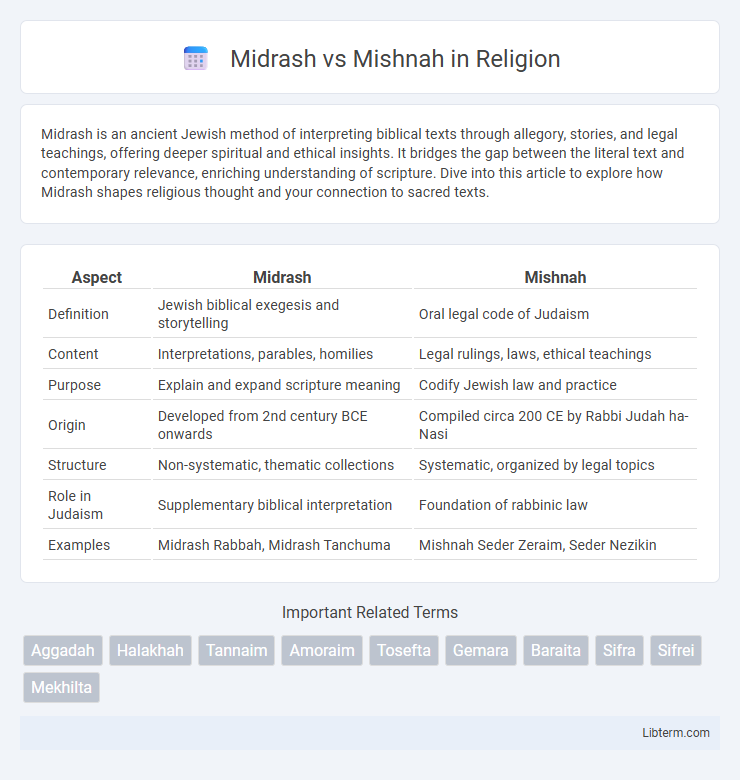Midrash is an ancient Jewish method of interpreting biblical texts through allegory, stories, and legal teachings, offering deeper spiritual and ethical insights. It bridges the gap between the literal text and contemporary relevance, enriching understanding of scripture. Dive into this article to explore how Midrash shapes religious thought and your connection to sacred texts.
Table of Comparison
| Aspect | Midrash | Mishnah |
|---|---|---|
| Definition | Jewish biblical exegesis and storytelling | Oral legal code of Judaism |
| Content | Interpretations, parables, homilies | Legal rulings, laws, ethical teachings |
| Purpose | Explain and expand scripture meaning | Codify Jewish law and practice |
| Origin | Developed from 2nd century BCE onwards | Compiled circa 200 CE by Rabbi Judah ha-Nasi |
| Structure | Non-systematic, thematic collections | Systematic, organized by legal topics |
| Role in Judaism | Supplementary biblical interpretation | Foundation of rabbinic law |
| Examples | Midrash Rabbah, Midrash Tanchuma | Mishnah Seder Zeraim, Seder Nezikin |
Understanding Midrash and Mishnah: Key Definitions
Midrash refers to a vast body of Jewish biblical interpretation that explores deeper meanings and ethical lessons through storytelling and legal exegesis. Mishnah is the foundational compilation of oral Jewish laws codified around 200 CE, forming the basis of the Talmud and serving as a primary source for halakhic rulings. Together, Midrash and Mishnah provide complementary approaches, with Midrash focusing on narrative and homiletic expansion and Mishnah on structured legal discourse.
Historical Origins of Midrash and Mishnah
The Mishnah, compiled around 200 CE by Rabbi Judah the Prince, represents the earliest written codification of Jewish oral law and legal discussions, forming the foundational layer of the Talmud. Midrash, originating earlier but extensively developed between the 2nd and 6th centuries CE, comprises exegetical narratives and homiletic teachings aimed at interpreting biblical texts beyond their literal meaning. Both emerge from distinct historical contexts: the Mishnah institutionalizes legal traditions post-Second Temple destruction, while Midrash evolves as a creative interpretative approach enriching scriptural understanding during the rabbinic period.
Core Purposes: Interpreting vs. Codifying
Midrash primarily serves the purpose of interpreting and explaining biblical texts through storytelling, homiletics, and allegorical insights, enriching the Torah with deeper meaning and practical lessons. The Mishnah, in contrast, functions as a legal codex that systematically compiles Jewish oral traditions into concise, authoritative laws governing religious practice and daily life. While Midrash explores the nuances of scripture for spiritual and ethical understanding, the Mishnah establishes a structured legal framework foundational to Rabbinic Judaism.
Literary Structure and Style Differences
The Midrash employs a homiletic style with expansive storytelling, allegories, and interpretative expansions on biblical texts, emphasizing moral and theological lessons through creative narrative techniques. The Mishnah, by contrast, exhibits a concise, legalistic structure organized into tractates, focusing on codified oral laws and practical rulings with precise language and systematic categorization. Midrash prioritizes thematic exploration and rhetorical embellishment, while the Mishnah prioritizes clarity, brevity, and juridical formulation within its literary framework.
Primary Themes in Midrash and Mishnah
Midrash primarily explores biblical narratives through detailed exegetical stories and moral lessons, focusing on divine justice, covenantal relationships, and ethical conduct. The Mishnah emphasizes legal rulings and practical applications of Jewish law, covering areas such as ritual purity, civil law, and festival observance. Both texts serve complementary roles in Jewish tradition, with Midrash providing interpretive context and the Mishnah establishing foundational Halakhic frameworks.
Role in Jewish Law and Tradition
The Mishnah serves as the foundational legal code of Jewish oral law, systematically organizing halakhic principles that guide religious practice and legal decisions. Midrash complements the Mishnah by offering interpretive narratives and homiletic explanations that elucidate biblical texts, enriching the understanding of Jewish law and tradition. Together, the Mishnah provides concrete legal rulings while the Midrash offers contextual insights, ensuring both legal precision and spiritual depth in Jewish scholarship.
Influential Texts: Examples of Midrashim and Mishnayot
The Mishnah, compiled around 200 CE by Rabbi Judah the Prince, includes foundational texts such as the Agriculture (Zeraim), Festivals (Moed), and Purities (Tohorot) orders, which systematically codify Jewish oral laws. Influential Midrashim like Midrash Rabbah and Midrash Tanchuma provide expansive narrative interpretations and homiletical expansions on biblical books, enriching legal and ethical discussions found in the Mishnah. These texts collectively serve as essential sources for understanding Jewish law, ethics, and theology, with the Mishnah offering legal framework and the Midrash bringing contextual and exegetical depth.
Methods of Interpretation and Analysis
Midrash employs a narrative and homiletic approach, using allegory, parables, and creative expansions to explore biblical texts, emphasizing moral and theological lessons. Mishnah uses a systematic and legalistic method, organizing oral laws into concise rulings and categories to provide clear halakhic guidance. These contrasting methodologies reflect Midrash's focus on interpretive storytelling and Mishnah's role in codifying Jewish law.
Influence on Later Rabbinic Literature
Midrash and Mishnah significantly shaped later Rabbinic literature, with the Mishnah providing the foundational legal framework that the Talmud extensively analyzes and expands. Midrash contributed rich exegetical narratives and homiletic interpretations that influenced the development of aggadic material within the Talmud and later Midrashic compilations. Together, these texts established interpretive and legal methodologies that underpinned medieval commentaries and continue to inform contemporary Jewish scholarship.
Contemporary Relevance and Study
Midrash and Mishnah remain central to contemporary Jewish learning, offering complementary approaches to understanding Torah. The Mishnah provides a foundational legal framework that guides modern halachic decisions, while Midrash enriches ethical and spiritual interpretation through narrative and homiletic expansion. Scholars and students engage with both to deepen legal analysis and explore evolving moral insights in today's diverse Jewish communities.
Midrash Infographic

 libterm.com
libterm.com